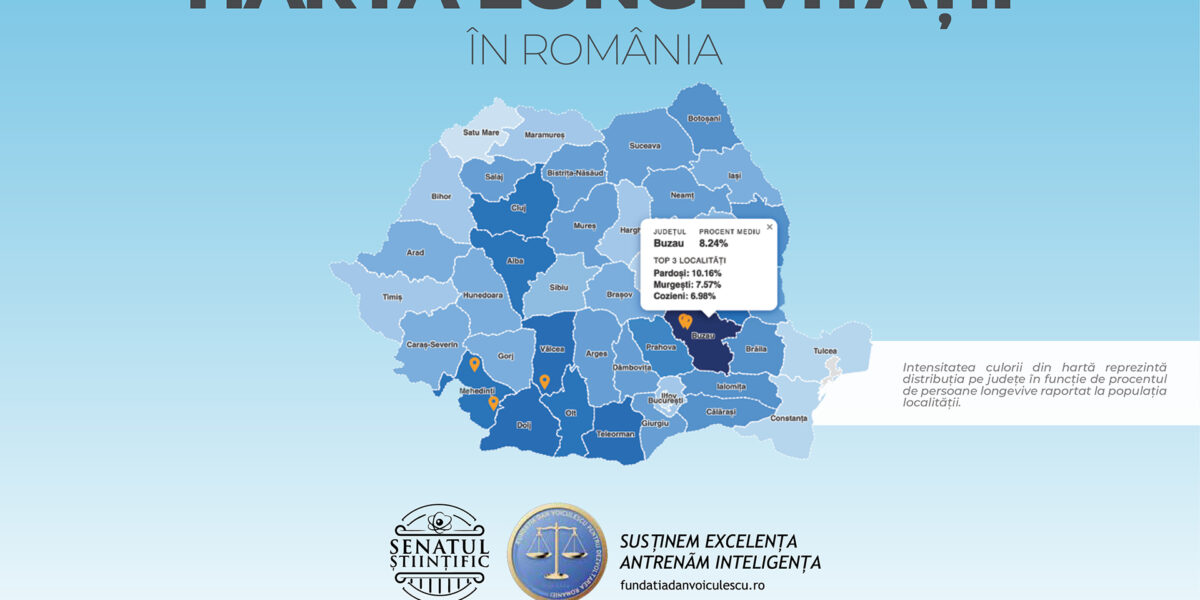The research project "Longevity Map of Romania", initiated by The Scientific Senate of the Dan Voiculescu Foundation for the Development of Romania, demonstrates that the specific lifestyle in some communities in Romania contributes significantly to longevity, thus confirming the characteristics of "blue zones" at international level.
The localities of Pardoși and Murgești in Buzău County, Cireșu in Mehedinți, Seaca de Pădure in Dolj and Glăvile in Vâlcea can be considered as Romania's true 'blue zones'." These communities, identified on the basis of the high prevalence of long-lived inhabitants, are located in rural hilly and mountainous areas, where the natural environment and isolation have favored the preservation of ancestral customs.
The results of the study are in accordance with those of international research, which indicates that environmental and lifestyle factors exert a greater influence on longevity than genetic factors. The findings of the Longevity Map of Romania project indicate that individuals over the age of 90 in the communities under study exhibited surprisingly good physical and mental health. Project coordinator Lăcrămioara Frăsineanu posited that "the rural environment, with low pollution and an active lifestyle, seems to be essential for a long life. People in these communities not only work hard physically until old age, but also live in harmony with nature, eating what they produce themselves".
The diet is predominantly plant-based and moderate in terms of calories, aligning with the concept of calorie restriction, which is globally recognised for its effects on longevity. According to Frăsineanu, lunch is the main meal of the day, and alcohol consumption is minimal, with the exception of an occasional glass of natural wine.
These people maintained their work habits even after 90 years, walking for miles every day. "People in the communities studied seem to have found a balance between work, rest and social interactions, which gives them a general sense of well-being," added the project coordinator.
Religious fasting and a deep spiritual connection with the divine play an essential role in the lifestyle of these communities. Harmonious relationships with family and community also contribute significantly to their overall well-being and longevity.
An example of longevity is Mrs. Lina Nedelcu, aged 97, from Seaca de Pădure. Even at this age, every day she spends her time mowing lawns and tending her garden. "We weren't having fun, we were working. We walked in the meadows with the cows and goats. There were no cars, there was nothing. We went to work with horse-drawn carts," Mrs. Nedelcu recounted about her life.
Also, medical tests carried out showed that seniors in the communities studied had normal values for most health biomarkers, such as blood glucose, cholesterol and blood pressure levels, showed no signs of age-related chronic diseases. "These people lived austere but healthy lives. Their simple lifestyle, without excesses, is probably the key to their longevity," emphasized Dr. Nicole Thomas, the physician who coordinated the medical evaluation of the subjects.
The findings of the "Longevity Map of Romania" project, presented on 9 October at the Romanian Academy Library, constitute a significant contribution to the global study of longevity. The participation of esteemed experts such as Dr. Waclaw Kroczek, an international researcher specialising in the study of supercentenarians, serves to reinforce the significance of this study for advancing our comprehension of the mechanisms underlying longevity and healthspan extension.

